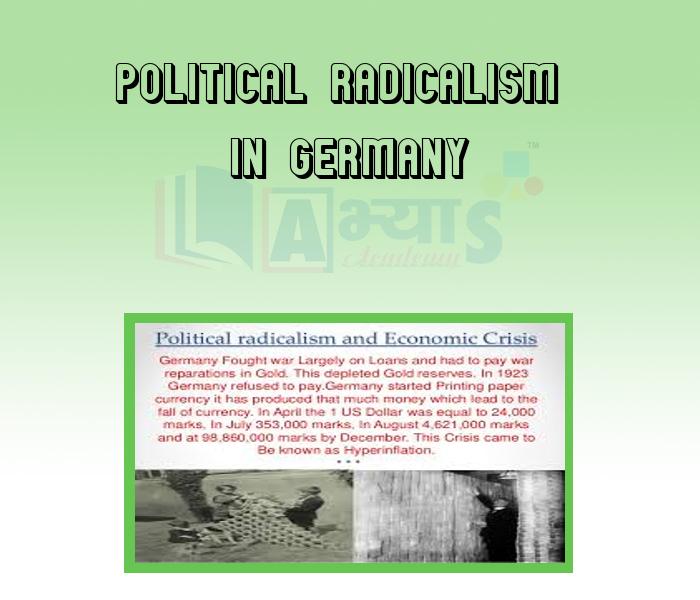Political Radicalism in Germany













Political Radicalism in Germany
Political Radicalism: A revolutionary uprising called Spartacist League came up along with the Weimar Republic. It was based on the pattern of the Bolshevik Revolution in Russia and demanded Soviet style governance. The Socialists, Democrats and the Catholics who were against the Spartacist League met at Weimar to establish a Democratic Republic. They crushed the uprising with the help of the "Free Corps", a war veterans organisation. Later the Spartacists formed the Communist Party of Germany. After this, the Communists and the Socialists became irreconcilable enemies and did not join together against Hitler.
Economic Crisis of 1923: Germany had taken loans for the war and had to pay war reparations only in gold. The gold reserves were depleted. The French occupied Ruhr, a leading industrial area, when Germany refused to pay the reparation. Germany printed paper currency recklessly, in retaliation. So the value of the German Mark collapsed and the prices of goods soared. The Dawes Plan was introduced to help Germany to come out of the financial crisis.
Political Radicalism in Germany: The political atmosphere in Berlin was charged with demands for Soviet-style governance. The Weimar Republic crushed the uprising of the Spartacist League with the help of the war veterans organisation called the Free Corps. The Spartacists later founded the Communist Party of Germany. The two parties of Communists and Socialists never worked together after this; thus they could not control the rise of Hitler.
Students / Parents Reviews [10]
A marvelous experience with Abhyas. I am glad to share that my ward has achieved more than enough at the Ambala ABHYAS centre. Years have passed on and more and more he has gained. May the centre flourish and develop day by day by the grace of God.

Archit Segal
7thIt was a good experience with Abhyas Academy. I even faced problems in starting but slowly and steadily overcomed. Especially reasoning classes helped me a lot.

Cheshta
10thIt has a great methodology. Students here can get analysis to their test quickly.We can learn easily through PPTs and the testing methods are good. We know that where we have to practice

Barkha Arora
10thAbhyas Methodology is very good. It is based on according to student and each child manages accordingly to its properly. Methodology has improved the abilities of students to shine them in future.

Manish Kumar
10thOne of the best institutes to develope a child interest in studies.Provides SST and English knowledge also unlike other institutes. Teachers are co operative and friendly online tests andPPT develope practical knowledge also.

Aman Kumar Shrivastava
10thAbhyas is a complete education Institute. Here extreme care is taken by teacher with the help of regular exam. Extra classes also conducted by the institute, if the student is weak.

Om Umang
10thMy experience with Abhyas academy is very good. I did not think that my every subject coming here will be so strong. The main thing is that the online tests had made me learn here more things.

Hiya Gupta
8thIt was good as the experience because as we had come here we had been improved in a such envirnment created here.Extra is taught which is beneficial for future.

Eshan Arora
8thI have spent a wonderful time in Abhyas academy. It has made my reasoning more apt, English more stronger and Maths an interesting subject for me. It has given me a habbit of self studying

Yatharthi Sharma
10thAbout Abhyas metholodology the teachers are very nice and hardworking toward students.The Centre Head Mrs Anu Sethi is also a brilliant teacher.Abhyas has taught me how to overcome problems and has always taken my doubts and suppoeted me.
